White tree fungus might look harmless at first, but it can have severe consequences for tree health. From stunting growth to causing structural damage, this silent invader is not to be underestimated. Use this guide to help you with identification and management of white tree fungus. Accurate identification and prompt action are key to combating tree pest & disease challenges. Let’s dive in!
Understanding White Tree Fungus
White tree fungus consists of various fungal species that are white or pale and grow on trees. These fungi can have fluffy coatings, crusty patches, or mushroom-like bodies. While some fungi are harmless decomposers, others are pathogens and can be detrimental to trees.
White tree fungus thrives in these conditions:
- Moisture: Prolonged wet conditions create a suitable environment for fungal growth.
- Poor Ventilation: Dense canopies and lack of airflow encourage fungal infection.
- Injuries: Wounds from pruning, storms, or pests are potential entry points for fungal spores.
- Weak Trees: Stress from drought, pests, or poor soil conditions makes trees more susceptible to fungi.
While pathogenic fungi harm trees, they also play roles in ecosystems. Some fungi decompose organic matter, recycling nutrients. However, aggressive fungal infections can disrupt local biodiversity by weakening or killing trees, which serve as habitat for many species.
How to Identify White Tree Fungus
Lookout for these common characteristics of white tree fungus:
- Color and Texture: White, creamy, or grayish hues; may appear fluffy, powdery, or crusty.
- Location: Found on leaves, bark, or roots.
- Growth Pattern: Irregular patches, often expanding over time.
Some of these tools may come in handy when identifying fungi:
- Magnifying Glass: Helps examine fungal structures closely.
- Fungus Guidebook or App: Provides images and descriptions for comparison.
- UV Light: Some fungal species fluoresce under ultraviolet light, helping with identification.
Fungal diseases are not the only issues that can cause tree stress and decline. To be certain if what you’re looking at is caused by fungi, look for:
- Fruiting Bodies: Look for visible mushrooms or spore-producing structures.
- Discolored Bark: White fungus often discolors bark, turning it wet or patchy.
- Unusual Leaf Symptoms: Wilting, yellowing, or a white powdery coating can signal fungal infections.
- Growths at the Base: Fungi like white rot often emerge around the tree’s base.
Common Types of White Tree Fungus
If you come across white fungus on your trees, chances are you have either powdery mildew or white rot fungus. Below is a quick rundown of the two.
Powdery mildew
Powdery mildew is a common white fungal disease that affects tree leaves and stems. Its characteristic powdery coating is unmistakable. While primarily an aesthetic concern, severe infestations can stunt growth and weaken trees over time.
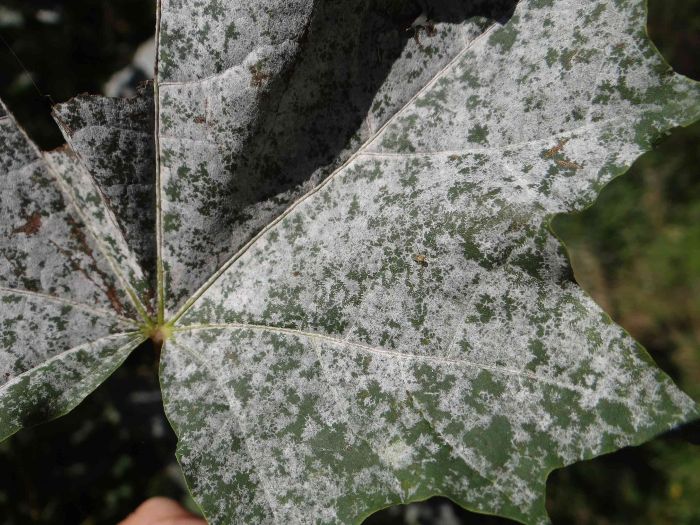
White rot
White rot targets the tree’s wood, breaking down lignin compounds that support the tree. This decay weakens the tree’s structure, making it prone to collapse. It’s called white rot because it turns the wood white or pale in color. White rot may also cause the wood to become spongy or crumbly.
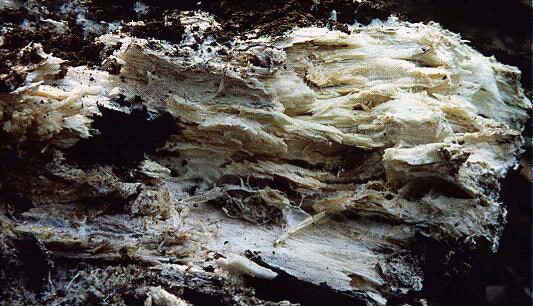
The type of white rot fungus you encounter varies across the United States based on climate and native tree species:
- Eastern U.S.: Armillaria spp. (commonly known as honey fungus) often causes white rot in hardwoods like oak and maple. These fungi are especially active in warm, humid conditions.
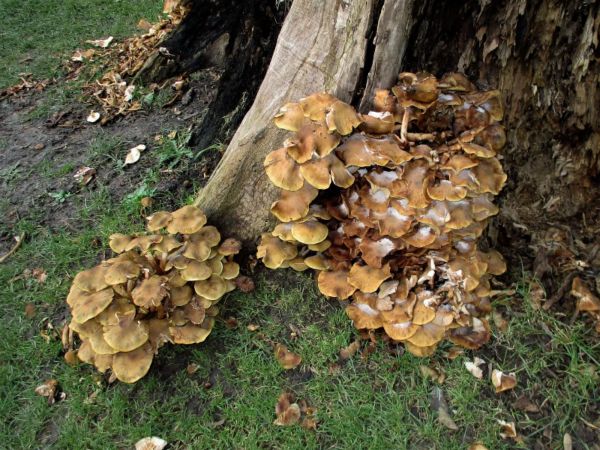
- Pacific Northwest: Ganoderma applanatum (artist’s conk) is prevalent, affecting conifers and hardwoods alike. It’s recognizable by its large, shelf-like fruiting bodies.
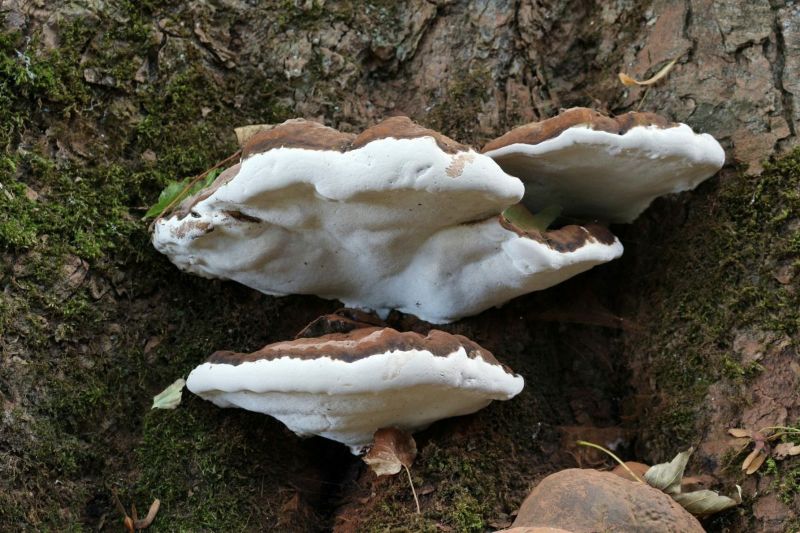
- Southern U.S.: Phellinus pini is commonly found on pine trees, particularly in areas with high humidity.

- Northern U.S.: Trametes versicolor (turkey tail fungus) frequently targets dead or decaying hardwoods, contributing to white rot in colder climates.
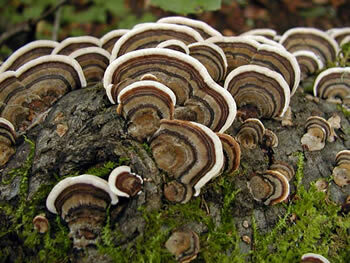
Knowing which species of fungi are common in your region helps speed up identification and treatment.
Impact of Fungal Tree Diseases
How fungal tree diseases harm trees:
- Compromise Structural Integrity: White rot can cause trees to become brittle and hazardous.
- Disrupt Nutrient Flow: Fungi block water and nutrient transport within the tree.
- Lead to Tree Death: Untreated infections can overwhelm a tree’s defenses.
Untreated infections can have these economic and environmental repercussions:
- Costly Tree Removals: Advanced fungal infections often require removal for preservation of safety.
- Loss of Shade and Aesthetics: Dead trees are eyesores, leave barren landscapes, and lower property value and appeal.
- Environmental Damage: Trees play a major role in carbon sequestration and biodiversity. Losing them can harm ecosystems.
Prevention and Management
Preventing white fungus from infecting your tree in the first place is ideal. Follow these tips to help keep white fungus at bay:
- Regular Pruning: Remove dead or diseased branches to limit fungal spread.
- Improve Air Circulation: Thin out dense canopies to reduce moisture retention.
- Mulching: Use organic mulch to retain soil moisture and regulate temperature.
- Water Wisely: Avoid overwatering because wet roots and soils encourage fungal infections.
If white fungus has set in, you can try these natural and chemical treatments to manage its growth.
- Natural Remedies: Neem oil and baking soda sprays can curb fungal spread.
- Fungicides: Choose broad-spectrum fungicides labeled safe for your tree species.
- Biological Controls: Introduce beneficial fungi that outcompete harmful species.
And remember, routine inspections and care are proactive practices that can save you a lot of headache and dollars in the long run. By maintaining your trees regularly, you can catch fungal infections early, strengthen trees against stressors, and preserve tree health and beauty.
DIY vs. Professional Help
DIY methods can be effective if your tree has mild infections like early-stage powdery mildew or small fungal patches. Routing care with basic pruning and application of natural remedies can help strengthen trees against further infections.
Consider calling a professional for help if the fungus is widespread because extensive white rot or mildew requires specialized treatment. Advanced fungal decay can also compromise structural integrity and endanger people or property. If you’re unsure about what type of fungus you have, consult a professional arborist because misidentification can lead to ineffective treatments.
Frequently Asked Questions (FAQ)
Can white tree fungus kill a tree?
- Yes, particularly aggressive fungi like white rot can weaken a tree to the point of collapse if untreated.
What are the early signs of fungus on tree?
- Look for white patches, discolored leaves, or spongy bark. Early detection is very important for effective treatment.
Are certain tree species more susceptible to fungal tree diseases?
- Yes, species like oak, maple, and fruit trees are often more prone due to the nature of their wood and sugary sap.
Conclusion
White tree fungus can be a silent but destructive force in your trees. By understanding the signs, causes, and treatments, you can protect your trees from irreversible damage. Preserve your trees’ health and protect your property by scheduling an assessment with A Plus Tree!





